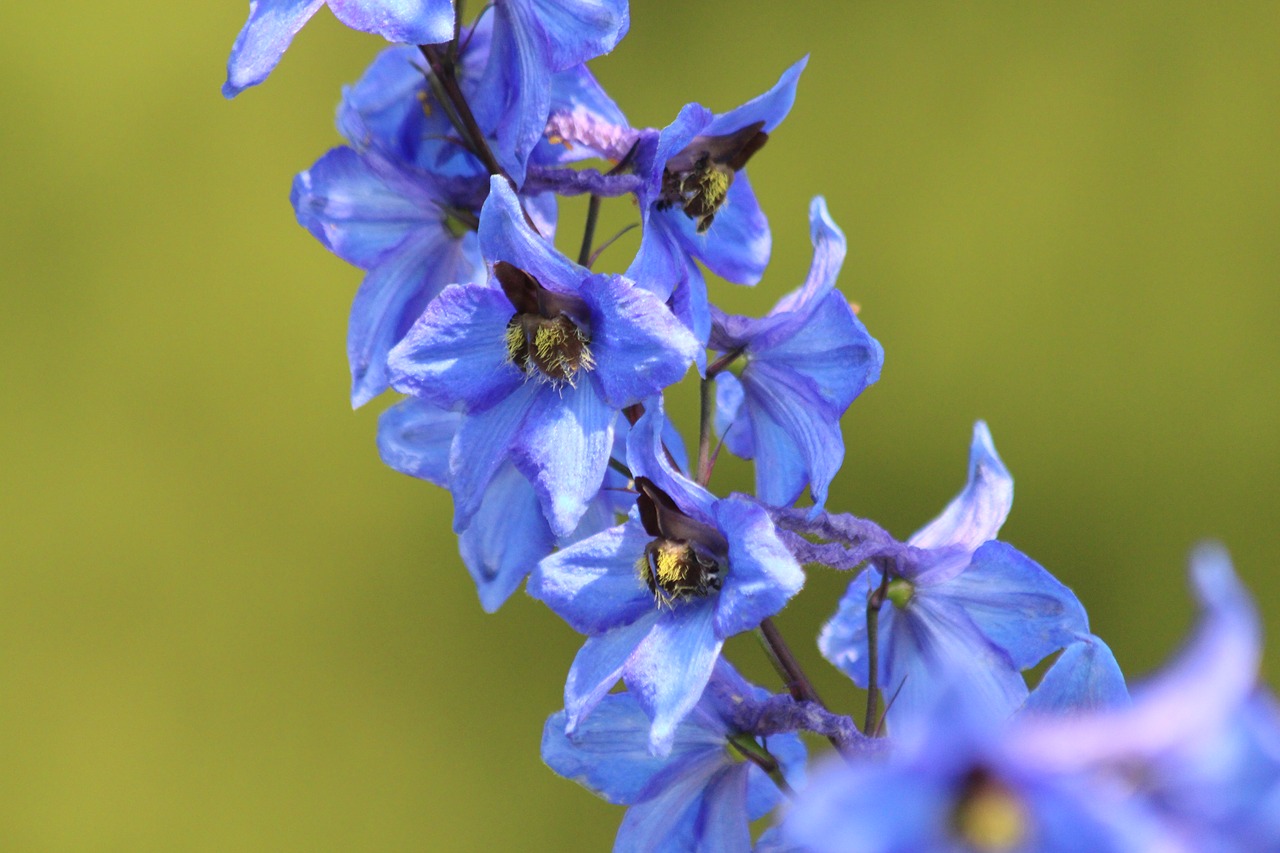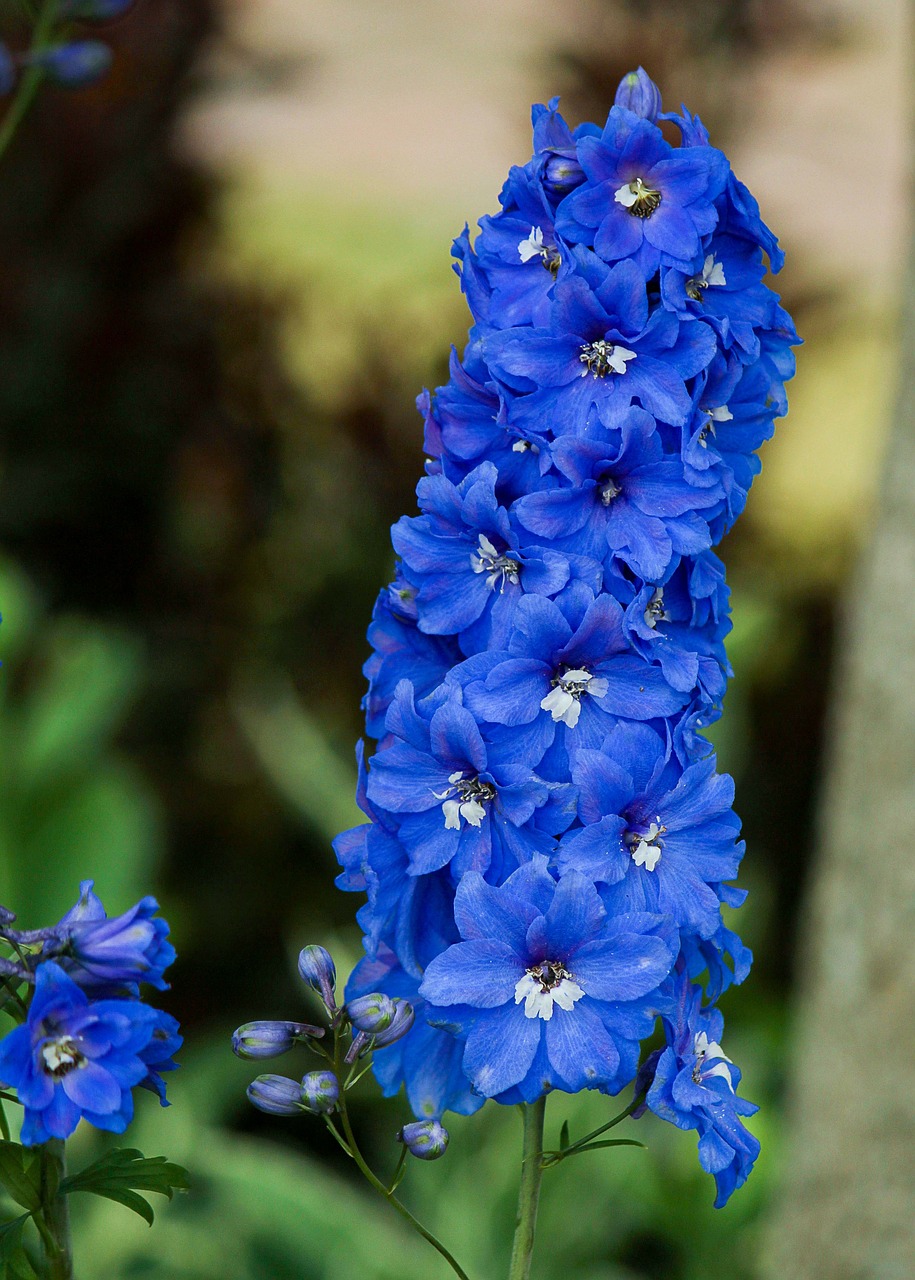Difference Between Delphinium and Larkspur
Ranunculaceae family consists of more than 2,000 annual and perennial plant species, distributed worldwide. The species are herbaceous, rarely shrubs, semi-shrubs, and lianas.
The family consists of 43 genera, including Ranunculus (600 species), Delphinium (370 species), Thalictrum (330 species), Consolida (40 species), etc.
The genera Delphinium and Consolida are collectively known with the common name Larkspur.
What is Delphinium?
Delphinium is a genus in the Ranunculaceae family, comprising of about 370 species. Its distribution ranges throughout the temperate regions of the northern hemisphere – from the Mediterranean region to Japan, Siberia, and North America.
The center of origin and diversity of the genus are the eastern Himalayas and southwest China. More than 40% of all Delphinium species are found there.
Delphinium occurs in a great variety of habits. Species, inhabiting the alpine zone are up to 10 cm tall, while some of the low-land species may grow more than 2 m tall.
The Delphinium species are annuals, biennials, and perennials. In general, the annual and biennial species are more typical for the Mediterranean areas, while perennial species are more common in cold and wet climate, and high altitude.
The name comes from the Greek word “delphisfor”, meaning dolphin and is related to the shape of the nectary spur, resembling the shape of a cetacean.
The nectary spur is an extension of one of the sepals. The flowers of Delphinium sp. are situated in a dense column. The flower has 3 to 5 pistils, thus forming 3 to 5 fruits.
Delphinium plants, ranging in color from blue and purple to pink and white are popular garden flowers. The genus includes medicinal and poisonous plants. The main bioactive components of the genus are diterpenoid alkaloids. Species of the genus have medicinal properties, including antiarrhythmic, arrhythmic, hypotensive, curariform, neurotropic, psychotropic, analgesic, anti-inflammatory, spasmolytic activity, etc. The plants can cause poisoning in cattle and in humans.
Representatives of the genus are Delphinium andersonii, Delphinium brunonianum, Delphinium luteum, Delphinium malabaricum, Delphinium viridescens, etc.
What is Larkspur?
Larkspur is a common name, collectively used for two genera of the Ranunculaceae family – Delphinium and Consolida.
The name “Larkspur” is related to the spur-shaped calyx of the flowers of both genera.
Delphinium and Consolida are closely related genera. Based on DNA analysis, some researchers suggest including Consolida in the Delphinium genus.
Consolida is a relatively small genus, of about 40 species. The species consists of annual flowering plants, native to Mediterranean region, Asia and Western Europe. The center of origin and diversity of the genus are Irano-Turanian region and the Mediterranean basin.
The flowers of Consolida species are situated in an open, often branched, loose, spike. Consolida species have only one pendant in the color and thus form only one fruit of each flower.
Larkspur species are popular cut flowers and garden plants. The group includes medicinal and poisonous plants. The main bioactive components are diterpenoid alkaloids. They have medicinal properties, including diuretic, hypnotic, purgative, vasodilator, antiarrhythmic, hypotensive, curariform, neurotropic, analgesic, anti-inflammatory, spasmolytic activity, etc. Larkspur species are used to kill ectoparasites. The plants can cause poisoning in cattle and in humans.
Examples of Larkspur are Delphinium andersonii, Delphinium arthriscifolium, Consolida cruciata, Consolida glandulosa, Consolida lineolata, etc.
Difference Between Delphinium and Larkspur
-
Definition
Delphinium: Delphinium is a genus in the Ranunculaceae family, comprising of about 370 species.
Larkspur: Larkspur is a common name, collectively used for two genera of the Ranunculaceae family – Delphinium and Consolida.
-
Number
Delphinium: Delphinium comprises of about 370 species.
Larkspur: Larkspur comprises of about 410 species.
-
Origin
Delphinium: The center of origin and diversity of the genus are the eastern Himalayas and southwest China.
Larkspur: The center of origin and diversity of the group are the eastern Himalayas, southwest China, Irano-Turanian region and the Mediterranean basin.
-
Name
Delphinium: The name comes from the Greek word “delphisfor”, meaning dolphin and is related to the shape of the nectary spur, resembling the shape of a cetacean.
Larkspur: The name “Larkspur” is related to the spur-shaped calyx of the flowers of both genera.
-
Morphology
Delphinium: The flowers of Delphinium sp. are situated in a dense column. The flower has 3 to 5 pistils, thus forming 3 to 5 fruits.
Larkspur: The flowers of Larkspur can be situated in a dense column or in an open, often branched, loose, spike. Each flower can have 3 to 5 pistils, thus forming 3 to 5 fruits, or only one pendant, thus forming only one fruit.
-
Medicinal properties
Delphinium: The medicinal properties of Delphinium include antiarrhythmic, arrhythmic, hypotensive, curariform, neurotropic, psychotropic, analgesic, anti-inflammatory, spasmolytic activity, etc.
Larkspur: The medicinal properties of Larkspur include diuretic, hypnotic, purgative, vasodilator, antiarrhythmic, hypotensive, curariform, neurotropic, analgesic, anti-inflammatory, spasmolytic activity, etc.
-
Examples
Delphinium: Examples of Delphinium are Delphinium andersonii, Delphinium brunonianum, Delphinium luteum, Delphinium malabaricum, Delphinium viridescens, etc.
Larkspur: Examples of Larkspur are Delphinium andersonii, Delphinium arthriscifolium, Consolida cruciata, Consolida glandulosa, Consolida lineolata, etc.
Delphinium vs Larkspur: Comparison Table
Summary of Delphinium vs Larkspur:
- Ranunculaceae family consists of 43 genera, including Ranunculus, Delphinium, Thalictrum, Consolida, etc.
- The genera Delphinium and Consolida are collectively known with the common name Larkspur.
- Delphinium comprises of about 370 species. Larkspur comprises of about 410 species.
- The center of origin and diversity of Delphinium are the eastern Himalayas and southwest China. The center of origin and diversity of the Larkspur are the eastern Himalayas, southwest China, Irano-Turanian region and the Mediterranean basin.
- The name “Delphinium” comes from the Greek word “delphisfor”, meaning dolphin and is related to the shape of the nectary spur, resembling the shape of a cetacean. The name “Larkspur” is related to the spur-shaped calyx of the flowers of both genera.
- The flowers of Delphinium sp. are situated in a dense column. Each flower has 3 to 5 pistils, thus forming 3 to 5 fruits. The flowers of Larkspur can be situated in a dense column or in an open, often branched, loose, spike. Each flower can have 1, 3, 4 or 5 pistils, thus forming 1, 3, 4 or 5 fruits.
- The medicinal properties of Delphinium include antiarrhythmic, arrhythmic, hypotensive, curariform, neurotropic, psychotropic, analgesic, anti-inflammatory, spasmolytic activity, etc. The medicinal properties of Larkspur include diuretic, hypnotic, purgative, vasodilator, antiarrhythmic, hypotensive, curariform, neurotropic, analgesic, anti-inflammatory, spasmolytic activity, etc.
- Examples of Delphinium are Delphinium andersonii, Delphinium brunonianum, Delphinium luteum, Delphinium malabaricum, Delphinium viridescens, etc. Examples of Larkspur are Delphinium andersonii, Delphinium arthriscifolium, Consolida cruciata, Consolida glandulosa, Consolida lineolata, etc.
- Difference Between Gallstones and Cholecystitis - September 5, 2021
- Difference Between Constipation and Cramping - August 4, 2021
- Difference Between Whole Genome Sequencing and Microarray - May 6, 2021
Search DifferenceBetween.net :
Leave a Response
References :
[0]Kozhuharova, K., K. Stoyanov, Ts. Raycheva. Anatomy and Morphology of Plants. Plovdiv: Academic Publishing House of the Agricultural University. 2011. Print.
[1]Mauseth, J. Botany. Burlington: Jones & Bartlett Publishers. 2014. Print.
[2]Nabors, M. Introduction to Botany. San Francisco: Pearson Benjamin Cummings. 2004. Print.
[3]Image credit: https://pixabay.com/photos/delphinium-larkspur-flowers-foliage-170235/
[4]Image credit: https://pixabay.com/photos/delphinium-blue-flower-flower-bloom-3943169/



